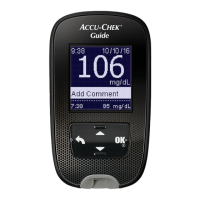20
Blood Glucose Tests
3
Symptoms of Low or High Blood
Glucose
WARNING
The meter is designed to provide a
numerical value for blood glucose in the
range of 20–600 mg/dL.
Being aware of the symptoms of low or
high blood glucose can help you
understand your test results and decide
what to do if they seem unusual.
Low blood glucose (hypoglycemia):
Symptoms of hypoglycemia may
include, but are not limited to, anxiety,
shakiness, sweating, headache,
increased hunger, dizziness, pale skin
color, sudden change in mood or
irritability, fatigue, diculty
concentrating, clumsiness, palpitations,
and/or confusion.
High blood glucose (hyperglycemia):
Symptoms of hyperglycemia may
include, but are not limited to, increased
thirst, frequent urination, blurred vision,
drowsiness, and/or unexplained weight
loss.
If you are experiencing any of these
symptoms, or other unusual symptoms,
test your blood glucose from the
fingertip. If your blood glucose result is
displayed as LO or HI, follow your
healthcare professional’s instructions
or contact your healthcare professional
immediately. If your blood glucose
result does not match how you feel,
follow the steps in the Unusual Blood
Glucose Results section of this chapter.
Comparing Your Meter Result to a
Laboratory Result
A common question is how the blood glucose
results on the meter compare to the
laboratory results. Your blood glucose can
change quickly, especially after eating,
taking medication, or physical activity. If you
test yourself in the morning, then go to your
healthcare professional’s oce for a blood
glucose test, your test results will probably
not match, even if you are fasting. This is
typically not a problem with the meter, it just
means that time has elapsed and your blood
glucose level has changed.
Although you always apply fresh capillary
whole blood to the test strip, the system has
been calibrated to deliver plasma-like values
for easier comparison to laboratory results.
If you want to compare your meter result to
the laboratory result, you must be fasting.
Take the meter to your healthcare
professional’s oce and test yourself by
fingerstick within 5 minutes of having blood
drawn from your arm by a healthcare
professional. Keep in mind that the
laboratory uses dierent technology than the
meter and that blood glucose meters for
self-testing generally read somewhat lower
than the laboratory result.
82052_08100918004.indd 20 6/9/2020 12:07:08 PM

